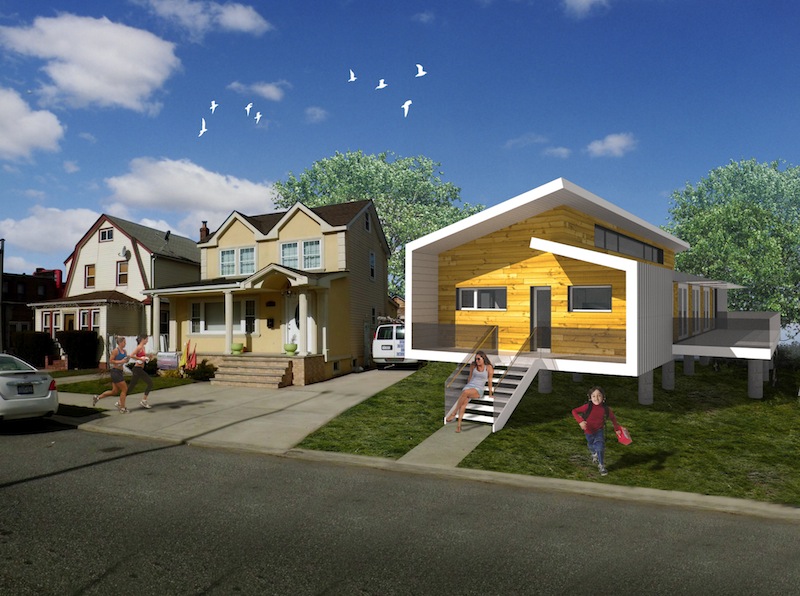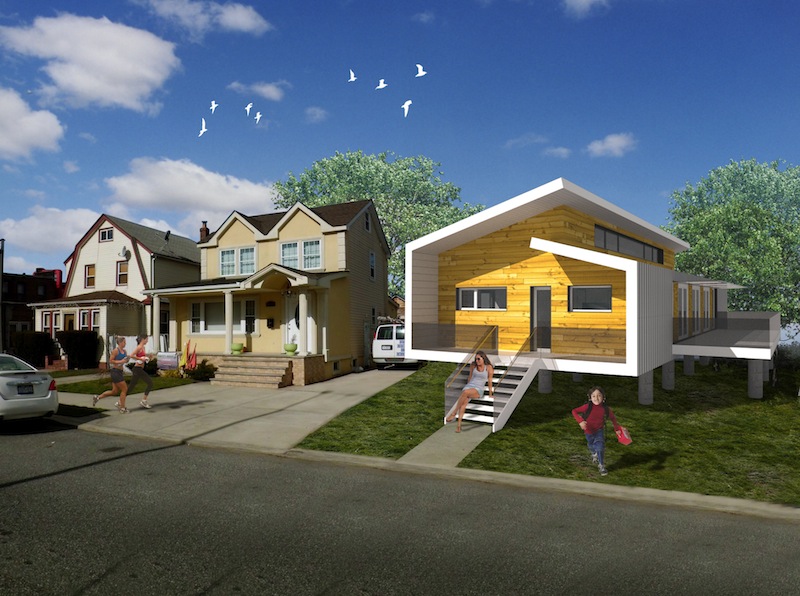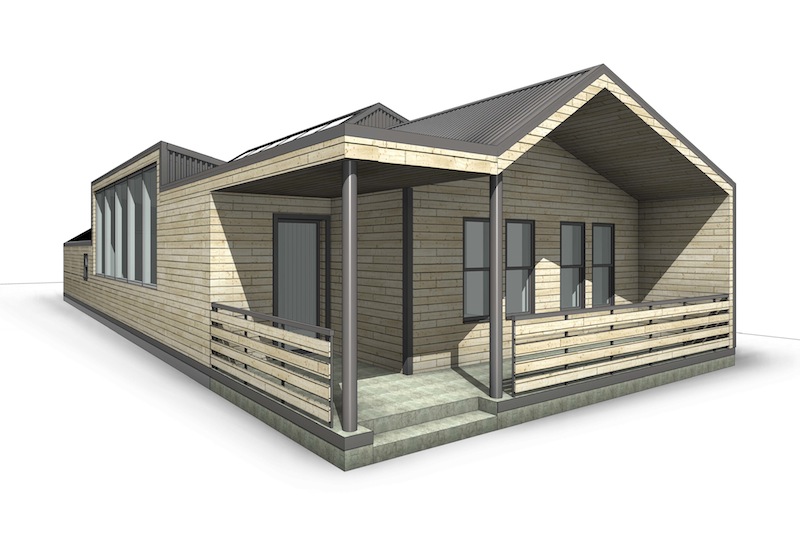The American Institute of Architects, in partnership with Make It Right, St. Bernard Project, Architecture for Humanity and Dow Building Solutions recently concluded “Designing Recovery,” an ideas competition created to aid in the rebuilding of sustainable and resilient communities. The competition was designed to help survivors of recent natural disasters in three distinct settings: New York City, New Orleans, and Joplin, Mo.
“When examining all of the designs submitted we continually asked ourselves if this would be a house we would want to live in regardless of safety considerations,” said Jury Chair, Michael Willis, FAIA, NOMA. “The three designs that we chose all had the ideal combination of addressing disaster mitigation and actual livability. The designs all had the sort of flexibility to be both a resilient safe haven during a natural disaster, but also serve as a dwelling that catered to family conditions and would blend into appropriate neighborhood styles without projecting a ‘bunker-like’ feeling.”
Although there could be just three winning designs, all of the entries that are feasible to construct will go into production in the corresponding communities and include:
1. Shotgun Remix
Designed by GOATstudio LLP, the Shotgun [remix] proposal for New Orleans offers a fresh, contemporary take on a familiar local typology. Modern touches like sliding polycarbonate privacy panels, vaulted interior spaces, clean, modern detailing, an open floor plan, and a steel roof that turns and wraps the southern exterior wall for additional sun protection update the historical shotgun form to better accommodate modern lifestyles and increased environmental challenges.
To help manage the threat from rising sea levels and increasing yearly rainfall, the finish floor will be elevated 7 feet above the ground plane and filter storm runoff through a perimeter rain garden, alleviating on-site ponding and reducing the load on strained city infrastructure. By employing similar construction methodologies and materials as those that have been thoroughly vetted by Make It Right since 2007, the design will be able to achieve LEED Platinum status and provide 6.25 kWh of solar energy to the owners.
2. Resilient House
Designed by Sustainable.TO Architecture + Building, the Resilient House for New York has a layout that orients living spaces towards the sun, and minimizes interior partitions. Structurally insulated panels allow for a tightly sealed and highly insulated building enclosure. Combined with a highly efficient ventilation system and upgraded windows, these design elements project to a 30% reduction in annual energy consumption. The house will be built above the floodplain with a flood-proof foundation to ensure natural disasters will not affect the structure. By using traditional construction methods and equipment, this dwelling can be built for less than $50,000 in material cost.
3. CORE House
Designed by Q4 Architects, CORE House in Joplin, MO is designed to address the local vernacular by combining two single-cell homes: a centrally located "Safe House" acts as the hearth and divides a "Perimeter House." The Safe House contains all of the functions of ‘home’ that are necessary for a family to recover quickly from disaster and live for an extended period of time until rebuilding is possible.
The walls of the Safe House are constructed of filled and anchored carbon-neutral concrete masonry units. Rainwater is collected, stored, and filtered for reuse. Locally sourced building materials were consciously considered so that CORE will have little impact on the progression of climate change, reduce the effects of debris in a natural disaster, and elevate local economies.
About The American Institute of Architects
Founded in 1857, members of the American Institute of Architects consistently work to create more valuable, healthy, secure, and sustainable buildings, neighborhoods, and communities. Through nearly 300 state and local chapters, the AIA advocates for public policies that promote economic vitality and public well-being. Members adhere to a code of ethics and conduct to ensure the highest professional standards. The AIA provides members with tools and resources to assist them in their careers and business as well as engaging civic and government leaders, and the public to find solutions to pressing issues facing our communities, institutions, nation and world. Visit www.aia.org.
About Architecture for Humanity
Architecture for Humanity is a nonprofit design services firm founded in 1999. By building a more sustainable future through the power of professional design, Architecture for Humanity taps a network of more than 75,000 professionals willing to lend time and expertise to help those who would not otherwise be able to afford their services. They bring design, construction and development services where they are most critically needed. For more information, please visit architectureforhumanity.org
St. Bernard Project
St. Bernard Project (SBP) is an award-winning rebuilding, nonprofit organization whose mission is to ensure that disaster-impacted citizens and communities recover in a prompt, efficient and predictable manner. Through its Disaster Recovery Lab, SBP works to share lessons learned, prevent common barriers to recovery, and help communities utilize SBP’s standardized, repeatable and proven-effective model. Since its founding in 2006, SBP has rebuilt homes for over 600 families in greater New Orleans, Louisiana and Joplin, Missouri with the help of 50,000 volunteers. In the wake of Hurricane Sandy, SBP is working on the ground in Rockaway and Staten Island, New York to help displaced families rebuild their homes and rebuild their lives. For more information, visit stbernardproject.org and sandy.stbernardproject.org.
Make It Right
Founded by Brad Pitt, Make It Right builds healthy, Cradle to Cradle-inspired homes, buildings and communities for people in need. Make It Right is currently working in New Orleans, LA, Newark, NJ, Kansas City, MO and the Fort Peck Reservation, MT. Learn more at www.makeitright.org.
Dow Building Solutions
Dow Building Solutions has a 60+ year legacy of providing energy saving solutions to the construction industry, which began with the launch of STYROFOAM™ Brand Extruded Polystyrene Foam Insulation. A business unit of The Dow Chemical Company, Dow Building Solutions offers insulation, air sealing and weatherization solutions to improve the performance of homes and buildings and reduce energy costs while contributing to the reduction of greenhouse gas emissions. Visit www.dowbuildingsolutions.com.
Related Stories
| Jan 19, 2011
Baltimore mixed-use development combines working, living, and shopping
The Shoppes at McHenry Row, a $117 million mixed-use complex developed by 28 Walker Associates for downtown Baltimore, will include 65,000 sf of office space, 250 apartments, and two parking garages. The 48,000 sf of main street retail space currently is 65% occupied, with space for small shops and a restaurant remaining.
| Jan 19, 2011
Biomedical research center in Texas to foster scientific collaboration
The new Health and Biomedical Sciences Center at the University of Houston will facilitate interaction between scientists in a 167,000-sf, six-story research facility. The center will bring together researchers from many of the school’s departments to collaborate on interdisciplinary projects. The facility also will feature an ambulatory surgery center for the College of Optometry, the first of its kind for an optometry school. Boston-based firms Shepley Bulfinch and Bailey Architects designed the project.
| Jan 19, 2011
Extended stay hotel aims to provide comfort of home
Housing development company Campus Apartments broke ground on a new extended stay hotel that will serve the medical and academic facilities in Philadelphia’s University City, including the University of Pennsylvania and the Children’s Hospital of Philadelphia. The 11,000-sf hotel will operate under Hilton’s Homewood Suites brand, with 136 suites with full kitchens and dining and work areas. A part of the city’s EnergyWorks loan program, the project aims for LEED with a green roof, low-flow fixtures, and onsite stormwater management. Local firms Alesker & Dundon Architects and GC L.F. Driscoll Co. complete the Building Team.
| Jan 19, 2011
Large-Scale Concrete Reconstruction Solid Thinking
Driven by both current economic conditions and sustainable building trends, Building Teams are looking more and more to retrofits and reconstruction as the most viable alternative to new construction. In that context, large-scale concrete restoration projects are playing an important role within this growing specialty.
| Jan 10, 2011
Michael J. Alter, president of The Alter Group: ‘There’s a significant pent-up demand for projects’
Michael J. Alter, president of The Alter Group, a national corporate real estate development firm headquartered in Skokie, Ill., on the growth of urban centers, project financing, and what clients are saying about sustainability.
| Jan 7, 2011
BIM on Target
By using BIM for the design of its new San Clemente, Calif., store, big-box retailer Target has been able to model the entire structural steel package, including joists, in 3D, chopping the timeline for shop drawings from as much as 10 weeks down to an ‘unheard of’ three-and-a-half weeks.
| Jan 7, 2011
How Building Teams Choose Roofing Systems
A roofing survey emailed to a representative sample of BD+C’s subscriber list revealed such key findings as: Respondents named metal (56%) and EPDM (50%) as the roofing systems they (or their firms) employed most in projects. Also, new construction and retrofits were fairly evenly split among respondents’ roofing-related projects over the last couple of years.
| Jan 7, 2011
Total construction to rise 5.1% in 2011
Total U.S. construction spending will increase 5.1% in 2011. The gain from the end of 2010 to the end of 2011 will be 10%. The biggest annual gain in 2011 will be 10% for new residential construction, far above the 2-3% gains in all other construction sectors.
| Jan 7, 2011
Mixed-Use on Steroids
Mixed-use development has been one of the few bright spots in real estate in the last few years. Successful mixed-use projects are almost always located in dense urban or suburban areas, usually close to public transportation. It’s a sign of the times that the residential component tends to be rental rather than for-sale.



















